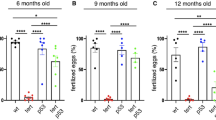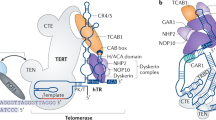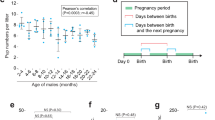Abstract
We have investigated the role of the enzyme telomerase in highly proliferative organs in successive generations of mice lacking telomerase RNA. Late-generation animals exhibited defective spermatogenesis, with increased programmed cell death (apoptosis) and decreased proliferation in the testis. The proliferative capacity of haematopoietic cells in the bone marrow and spleen was also compromised. These progressively adverse effects coincided with substantial erosion of telomeres (the termini of eukaryotic chromosomes) and fusion and loss of chromosomes. These findings indicate an essential role for telomerase, and hence telomeres, in the maintenance of genomic integrity and in the long-term viability of high-renewal organ systems.
This is a preview of subscription content, access via your institution
Access options
Subscribe to this journal
Receive 51 print issues and online access
$199.00 per year
only $3.90 per issue
Buy this article
- Purchase on Springer Link
- Instant access to full article PDF
Prices may be subject to local taxes which are calculated during checkout




Similar content being viewed by others
References
Greider, C. W. Telomere length regulation. Annu. Rev. Biochem. 65, 337–365 (1996).
Muller, H. J. The remaking of chromosomes. Collect. Net 8, 182–195 (1938).
McClintock, B. The stability of broken ends of chromosomes in Zea mays. Genetics 26, 234–282 ( 1941).
Greider, C. W. Chromosome first aid. Cell 67, 645– 647 (1991).
Greider, C. W. & Blackburn, E. H. Identification of a specific telomere terminal transferase activity in Tetrahymena extracts. Cell 43, 405–413 ( 1985).
Greider, C. W. & Blackburn, E. H. Atelomeric sequence in the RNA of Tetrahymena telomerase required for telomere repeat synthesis. Nature 337, 331–337 (1989).
Feng, J.et al. The RNA component of human telomerase. Science 269, 1236–1241 (1995).
Lingner, J.et al. Reverse transcriptase motifs in the catalytic subunit of telomerase. Science 276, 561–567 (1997).
Harrington, L.et al. Human telomerase contains evolutionarily conserved catalytic and structural subunits. Genes Dev. 11, 3109–3115 (1997).
Kilian, A.et al. Isolation of a candidate human telomerase catalytic subunit gene, which reveals complex splicing patterns on different cell types. Hum. Mol. Genet. 6, 2011–2019 (1997).
Nakayama, J.et al. Telomerase activation by hTRT in human normal fibroblasts and hepatocellular carcinomas. Nature Genet. 18, 65–68 (1998).
Meyerson, M.et al. HEST2, the putative human telomerase catalytic subunit gene, is upregulated in tumor cells and during immortalization. Cell 90, 785–795 ( 1997).
Nakamura, T. M.et al . Telomerase catalytic subunit homologs from fission yeast and human. Science 277, 955– 959 (1997).
Harley, C. B., Futcher, A. B. & Greider, C. W. Telomeres shorten during aging of human fibroblasts. Nature 345, 458–460 (1990).
Hastie, N. D.et al. Telomere reduction in human colorectal carcinoma and with ageing. Nature 346, 866–868 (1990).
Bodnar, A. G.et al. Extension of life-span by introduction of telomerase into normal human cells. Science 279, 349– 352 (1998).
Counter, C. M.et al . Telomere shortening associated with chromosome instability is arrested in immortal cells which express telomerase activity. EMBO J. 11, 1921–1929 ( 1992).
Prowse, K. R. & Greider, C. W. Developmental and tissue-specific regulation of mouse telomerase and telomere length. Proc. Natl Acad. Sci. USA 92, 4818–4822 (1995).
Kim, N. W.et al. Specific association of human telomerase activity with immortal cells and cancer. Science 266, 2011– 2015 (1994).
Blasco, M. A.et al. Telomere shortening and tumor formation by mouse cells lacking telomerase RNA. Cell 91, 25– 34 (1997).
Singer, M. S. & Gottschling, D. E. TLC1: template RNA component of Saccharomyces cerevisiae telomerase. Science 266, 403–409 (1994).
McEachern, M. J. & Blackburn, E. H. Runaway telomere elongation caused by telomerase RNA gene mutations. Nature 376, 403–409 (1995).
Haber, J. E. & Thorburn, P. C. Healing of broken linear dicentric chromosomes in yeast. Genetics 106, 207– 226 (1984).
Sandell, L. L. & Zakian, V. A. Loss of a yeast telomere: arrest, recovery, and chromosome loss. Cell 75, 729–739 (1993).
Wright, S. Systems of mating. Genetics 6, 111– 178 (1921).
Drost, J. B. & Lee, W. R. Biological basis of germline mutation: comparisons of spontaneous germline mutation rates among Drosophila, mouse, and human. Environ. Mol. Mutagen. 25 (suppl. 26), 48–64 (1995).
Shima, H., Motomu, T., Young, P. & Cunha, G. R. Postnatal growth of mouse seminal vesicle is dependent on 5α-dihydrotestosterone. Endocrinology 127, 3222–3233 (1990).
Erslev, A. J. & Lichtman, M. A. in Hematology 4th edn 37–47 (McGraw-Hill, (1993).
Buchkovich, K. J. & Greider, C. W. Telomerase regulation during entry into the cell cycle in normal human T cells. Mol. Biol. Cell 7, 1443–1454 (1996).
Weng, N.-P., Levine, B. L., June, C. H. & Hodes, R. J. Regulated expression of telomerase activity in human T lymphocyte development and activation. J. Exp. Med. 183, 2471– 2479 (1996).
Bodnar, A.. G., Kim, N. W., Effros, R. B. & Chiu, C. P. Mechanism of telomerase induction during T cell activation. Exp. Cell Res. 228, 58–64 ( 1996).
Garagna, S.et al. Robertsonian metacentrics of the house mouse lose telomeric sequences but retain some minor satellite DNA in the pericentromeric area. Chromosoma 103, 685–692 (1995).
Nanda, I., Schneider-Rasp, S., Winking, H. & Schmid, M. Loss of telomeric sites in the chromosomes of Mus musculus domesticus (Rodentia: Muridae) during Robertsonian rearrangement. Chromosome Res. 3, 399–409 ( 1995).
Zijlmans, J. M.et al . Telomeres in the mouse have large inter-chromosomal variations in the number of T2AG3repeats. Proc. Natl Acad. Sci. USA 94, 7423–7428 (1997).
Saltman, D., Morgan, R., Cleary, M. L. & de Lange, T. Telomeric structure in cells with chromosome end associations. Chromosoma 102, 121 (1993).
McEachern, M. J. & Blackburn, E. H. Cap-prevented recombination between terminal telomeric repeat arrays (telomere CAPR) maintains telomeres in Kluyveromyces lactis lacking telomerase. Genes Dev. 10, 1822–1834 ( 1996).
Kipling, D. & Cooke, H. J. Hypervariable ultra-long telomeres in mice. Nature 347, 400– 402 (1990).
Watt, S. M. & Visser, J. W. M. Recent advances in the growth and isolation of primitive human haemopoietic progenitor cells. Cell Prolif. 25, 263–297 (1992).
Vindelov, L. L., Christensen, I. J. & Nissen, N. L. Adetergent-trypsin method for the preparation of nuclei for flow cytometric DNA analysis. Cytometry 3, 323–327 (1983).
Morgenbesser, S. D. et al. P53-dependent apoptosis produced by Rb-deficiency in the developing mouse lens. Nature 371, 72–74 (1994).
Cannizzaro, L. A. & Shi, G. Fluorescent in situ hybridization (FISH) for DNA probes in the interphase and metaphase stages of the cell cycle. Methods Mol. Biol. 75, 313–322 (1997).
Acknowledgements
We thank L. Cannizzaro, M. Zohouri, D. Gebhard, R. Mazzaccaro, B. Furman, K.E.Cedeno-Baier, L. Husted, A. Silverman, N. Squillante, H. Hou and J. Lauridsen for advice and assistance; N. Schreiber-Agus, R. Greenberg, L. Chin, J. Pollard, E. R. Stanley and R. Kucherlapati for critical reading of the manuscript and advice; and E. Herrera and J. M. Caballero for sharing the dermatitis data collected in the National Center of Biotechnology (Madrid) before publication. Work in the lab of R.A.D. was supported by the NIH, AHA Grant-in-Aid and a Liver Center Initiative. R.A.D. is a recipient of the Irma T. Hirschl Career Scientist Award. R.A.D. and C.W.G. are also supported by Cancer Core grants. Work in the lab of C.W.G. was supported by the NIH and by Geron Corporaiton. M.A.B. was supported by the Leukemia Society of America, a grant from the Ministry of Education of Spain, and the Department of Immunology and Oncology (founded by the Spanish research Council and Pharmacia-Upjohn). H.W.L. was supported by an NIH postdoctoral training grant.
Author information
Authors and Affiliations
Rights and permissions
About this article
Cite this article
Lee, HW., Blasco, M., Gottlieb, G. et al. Essential role of mouse telomerase in highly proliferative organs. Nature 392, 569–574 (1998). https://doi.org/10.1038/33345
Received:
Accepted:
Issue Date:
DOI: https://doi.org/10.1038/33345
This article is cited by
-
Telomere-based treatment strategy of cardiovascular diseases: imagination comes to reality
Genome Instability & Disease (2024)
-
Adaptive and Maladaptive Clonal Hematopoiesis in Telomere Biology Disorders
Current Hematologic Malignancy Reports (2024)
-
Chromosome ends and the theory of marginotomy: implications for reproduction
Biogerontology (2024)
-
Senescence-related impairment of autophagy induces toxic intraneuronal amyloid-β accumulation in a mouse model of amyloid pathology
Acta Neuropathologica Communications (2023)
-
Targeting the “hallmarks of aging” to slow aging and treat age-related disease: fact or fiction?
Molecular Psychiatry (2023)
Comments
By submitting a comment you agree to abide by our Terms and Community Guidelines. If you find something abusive or that does not comply with our terms or guidelines please flag it as inappropriate.



